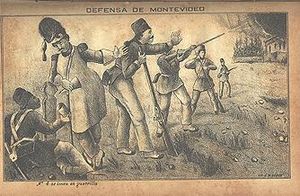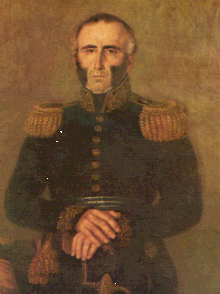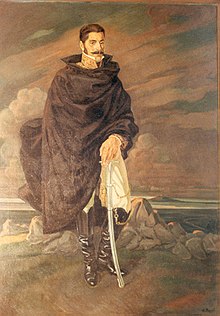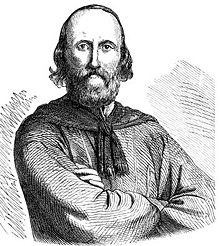Uruguayan Civil War
| Uruguayan Civil War | |||||||
|---|---|---|---|---|---|---|---|
 An illustration of the defense of Montevideo from Isidoro De-Maria's book,Anales de la defensa de Montevideo | |||||||
| |||||||
| Belligerents | |||||||
|
| ||||||
| Commanders and leaders | |||||||
| History ofUruguay |
|---|
 |
|
|
TheUruguayan Civil War,also known inSpanishas theGuerra Grande( "Great War" ), was a series of armed conflicts between the leaders of Uruguayan independence. While officially the war lasted from 1839 until 1851, it was a part of armed conflicts that started in 1832 and continued until the final military defeat of theBlancosfaction in 1904.
Supporters of the two opposing presidentsRiveraandOribeformed two political parties: theColorado Partyand theNational Party,both of which received backing and support from foreign sources, including neighboringEmpire of Brazil,theArgentine Confederation,Buenos Aires Provinceas well as European powers, primarily theBritish Empireand theKingdom of France,but also a legion ofItalianvolunteers includingGiuseppe Garibaldi.The great diversity of nationalities among the military forces supporting the Colorado Party posed difficulties in arguing for their struggle in terms of a "national liberation"; instead, the Colorado Party side argued that they were defending "humanity" and "civilization" against "tyranny".[1]
Rivera vs. Lavalleja
[edit]

After the proclamation of Uruguayan Independence in 1828 a conflict for primacy arose between the leader of theThirty-Three OrientalsJuan Lavallejaand veteran military commanderFructuoso Rivera,who on November 6, 1830, was chosen as the first President of Uruguay. In June 1832 Lavalleja's supporters attempted to kill Rivera and on July 3 the Montevideo garrison revolted, calling for Lavalleja to be made Commander-in-Chief. Rivera, with the help of Argentine Unitarians defeated Lavalleja on September 18, 1832, atTupambaé,forcing Lavalleja to flee to the Brazilian province ofRio Grande do Sul.There Lavalleja organized a new force with the support of Buenos Aires strongmanJuan Manuel de Rosasand in March 1834 invaded Uruguay, only to be defeated by Rivera once again.[2]
Rivera vs. Oribe
[edit]
On March 1, 1835, Manuel Oribe, another of the Thirty-Three Orientals, was elected as the second President of Uruguay while Rivera remained as the commander of Army. Oribe pursued his own policies and in January 1836 removed Rivera from the command and gave amnesty to his old comrade Lavalleja.
Blancos vs. Colorados
[edit]
On July 16, 1836, Rivera rebelled against Oribe. To distinguish his soldiers, Oribe ordered them to wear a white armband. Rivera then ordered his supporters to wear blue, but as it quickly faded, they started using red armbands. Out of these military distinction marks quickly emerged the conservativeBlancos( "Whites" ) and the liberalColorados( "Reds" ). TheColoradoswere led byFructuoso Riveraand represented the business interests ofMontevideo;theBlancoswere headed byManuel Oribe,who looked after the agricultural interests of the countryside and promoted protectionism.
Defeat of Oribe
[edit]In order to support Oribe, Lavalleja organized an army in Argentina and moved against Rivera, who was helped by Argentine Unitarians led by GeneralJuan Lavalle.On September 19, 1836, Rivera was defeated at theBattle of Carpinteríaand fled to Brazil, where his troops joined the newly proclaimedRiograndense Republic.With the help of this republic Rivera invaded Uruguay in 1837 and on October 22 defeated Oribe's forces at theBattle of Yucutujáand completely crushed Oribe on June 15, 1838Battle of Palmar.[2]
In 1838, France had started anaval blockadeofBuenos Airesport in support of their allies thePeru–Bolivian Confederationwho were involved in theWar of the Confederationwith theArgentine ConfederationandChile.Unable to deploy land troops, France looked for allied forces to fight Buenos Aires strongmanJuan Manuel de Rosason their behalf. For this purpose they supportedFructuoso Riveraand helped him to defeat Oribe, who was on good terms with Rosas.[3]On October 24, 1838, Oribe resigned and fled to Buenos Aires, and Rivera assumed power.
Return of Oribe
[edit]Rosas did not recognize Rivera as a legitimate President, and sought to restore Oribe to power. Rivera andJuan Lavalleprepared troops to attack Buenos Aires. At this point, both the British and French troops intervened, transforming the conflict into an international war.[4]
On December 6, 1842, theBlancosunder Manuel Oribe and theColoradosunder Fructuoso Rivera fought theBattle of Arroyo Grande.Rivera's forces were utterly defeated, and Oribe laid siege to Montevideo.[5]
Great Siege of Montevideo
[edit]
With the destruction of the Uruguayan army at the battle of Arroyo Grande, it was assumed that the country's capital, Montevideo, would fall to the combined forces of the Buenos Aires governorJuan Manuel de Rosasand the former Uruguayan president Manuel Oribe.[6]However, Oribe's siege of Montevideo lasted for nine years.[4]The newly freed slaves, who formed a contingent 5,000 strong, and the community of foreign exiles were mostly responsible for the defense of the city.[6]By 1843 Montevideo's population of thirty thousand inhabitants was highly cosmopolitan with Uruguayans making up only a third of it.[1]The remaining were chiefly Italian (4205), Spanish (3406), Argentine (2,553), Portuguese (659), English (606) and Brazilians (492).[1]
During this time Uruguay had two parallel governments:
- Gobierno de la Defensain Montevideo, led byJoaquín Suárez(1843–1852)
- Gobierno del Cerrito(with headquarters at the present neighbourhoodCerrito de la Victoria), ruling the rest of the country, led byManuel Oribe(1843–1851)
TheBritish Empireeventually saved the city by allowing it to receive supplies. First, the British and French naval forces temporarily blockaded the port of Buenos Aires during December 1845. Then, the French and British fleets protected Montevideo from the sea. French, Spanish and Italian legionnaires, led byGiuseppe Garibaldi,teamed up with the Colorados in defending the city.[7]Also in 1846, the 73rd (Perthshire) Regiment of Foot, sent by Britain, arrived in Montevideo and defended it for seven months against besieging Argentine troops.[8]
Historians believe that the French and British forces intervened in the region to ensure free navigation along theRio ParanaandRio Uruguay.However, in 1850, both the French and British withdrew after signing a treaty which represented a triumph forJuan Manuel de Rosasand hisFederal Partyin Argentina.[4]
After the withdrawal of British and French troops, it appeared that Montevideo would fall to Juan Manuel de Rosas and Oribe. However, an uprising against de Rosas led by fellow FederalistJusto José de Urquiza,governor of Argentina'sEntre Ríos Province,with the assistance of a small Uruguayan force, changed the situation completely. Manuel Oribe was defeated in 1851, leaving theColoradosin full control of the country. Brazil followed up by intervening in Uruguay in May 1851, supporting theColoradoswith financial and naval forces. This led to thePlatine Warwith Rosas in August 1851. In February 1852, after being defeated atCaseros,Rosas resigned and Urquiza's pro-Coloradoforces lifted the siege of Montevideo.[4]
Aftermath
[edit]The government of Montevideo rewarded Brazil's financial and military support at the final stages of the war by signing five treaties in 1851 that provided for perpetual alliance between the two countries.[citation needed]
Brazil was required to extradite runaway slaves and criminals from Uruguay. In fact, during the war, both the Blancos and the Colorados hadabolished slaveryin Uruguay to reinforce their respective military forces.
The treaties also allowed joint navigation on theRio Uruguayand its tributaries and exempted cattle and salted meat exports from taxes. The Uruguayan cattle industry was devastated by the war. The treaty also acknowledged Uruguay's debt to Brazil for its aid against theBlancosand Brazil's commitment for granting an additional loan.
Uruguay renounced its territorial claims north of theRío Cuareim,thereby reducing its area to about 176,000 square kilometers, and recognized Brazil's exclusive right of navigation in theLaguna Merinand theRio Yaguaron,the natural border between both countries.[4]
Later conflicts
[edit]Both parties were weary of the chaos. In 1870, they came to an agreement to define spheres of influence: the Colorados would control Montevideo and the coastal region, the Blancos would rule the hinterland with its agricultural estates. In addition, the Blancos were paid half a million dollars to compensate them for the loss of their stake in Montevideo. But thecaudillomentality was difficult to erase from Uruguay and political feuding continued culminating in theRevolution of the Lances(Revolución de las Lanzas) (1870–1872), and later with the uprising ofAparicio Saravia.
In popular culture
[edit]French authorAlexandre Dumas,in his novelThe New Troy,described Oribe's siege of Montevideo as a newTrojan war.[4]
Battles and sieges
[edit]- Battle of Arroyo Grande– December 6, 1842
- Siege of Montevideo– 1843
- Siege of Montevideo– 1851
See also
[edit]References
[edit]- ^abcEtchechury Barrera, Mario (2017).""Defensores de la humanidad y la civilización". Las legiones extranjeras de Montevideo, entre el mito cosmopolita y la eclosión de las 'nacionalidades' (1838–1851) ".Historia(in Spanish).50(II): 491–524.
- ^abLatin America’s Wars
- ^Garibaldi in Uruguay:A Reputation Reconsidered.
- ^abcdef"The Great War, 1843–52".[full citation needed]
- ^George Bruce, Harbottle's Dictionary of Battles. Van Nostrand Reinhold, 1981.ISBN0-442-22336-6.
- ^ab"The Anthony P. Campanella Collection of Giuseppe Garibaldi".
- ^McLean, David (April 1998). "Garibaldi in Uruguay: A Reputation Reconsidered".The English Historical Review.113(451). Oxford University Press: 351–366.doi:10.1093/ehr/CXIII.451.351.
- ^"In 1846 the 73rd (Perthshire) Regiment of Foot sailed from Cork, and after a brief stop at Rio de Janeiro, moved to Montevideo, which it defended for seven months against the attacking Argentinian forces." William Pratt Paul (1971),The Highland Regiments: Tigers in Tartan,Impulse, p. 19.
- Uruguayan Civil War
- Wars involving Argentina
- Wars involving Brazil
- Wars involving France
- Wars involving the United Kingdom
- Wars involving Uruguay
- Civil wars involving the states and peoples of South America
- Civil wars of the 19th century
- Revolution-based civil wars
- Proxy wars
- 1830s in Uruguay
- 1840s in Uruguay
- 1850s in Uruguay
- 1840s conflicts
- 1850s conflicts
- Conflicts in 1839

